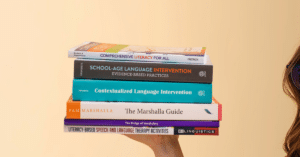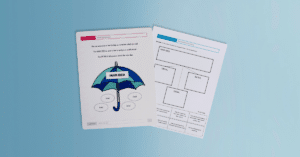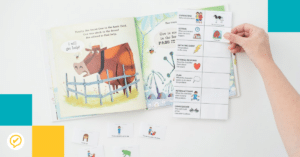Listen on Apple Podcasts Listen on Spotify
Phonological Awareness: Treatment Ideas
We are chugging along on this PA train!
So far in this series, we’ve done a quick review of phonological awareness and why is it is so important. Last week we shared phonological assessment resources and phonological awareness goal examples.
This week we get to dive into treatment ideas. Are you excited? Because I know I am! Monica will share some of her favorite treatment ideas and tips on how to get the student engaged with the activity while still focusing on those PA targets!
Let’s get to it!
Phonological Awareness Activities
– The University of Florida Literacy Institute has a list of phonological awareness activities (some are multisensory and include movement)
– The Children’s Learning Insitute at University of Texas (UT) has some phonemic awareness activities.
– I do activities that are embedded in SSD practice, I just need a whiteboard *bolded are the ones I usually do in sessions
Syllable awareness
Example: Clap out how many syllables there are
How many syllables did you hear? You clap this one out, how many are there?
Rhyme awareness and production
Example: Minimal pairs/any kind of pairs
Alliteration
Example: Look for words that start with the same sound. What sound do you hear? What else starts with that sound.
Onset-rime segmentation
Example: What’s the beginning of cat? /k/ what’s the end /at/ -> put it together
Initial and final sound segmentation
Example: What’s the first sound? In tab? /t/ what’s the final sounds or end sound /b/
Blending sounds into words
Example: If I say /s/ /n/ /o/ what word is that?
Segmenting words into sounds
Example: Break down snow into sounds /s/ /n/ /o/
Deleting and manipulating sounds
Example: Say /nail/ now add and /s/ and say /snail/
Use the target words you already have. Most likely you’re doing these things already.
Links Mentioned and Additional Research
– Gillion, 2000:
Compared traditional articulation to phonological awareness intervention (check out the article for the full details, but we’ll share some of the activities today).
The children who received phonological awareness intervention made significantly more gains in their phonological awareness ability and reading development than the children receiving the other types of speech and language intervention.
The phonological awareness intervention also improved the children’s speech articulation.
– “Hesketh (2009) says, “My intervention principle is to incorporate PA-type activities in support of speech change using stimuli relevant to the child’s target processes, syllable structures, contrasts or sounds, rather than seeing PA skills as a target in their own right. A typical intervention session will involve the child in listening to, thinking about and producing sounds but the balance between these three elements varies enormously across children and across sessions.”
Subscribe & Review in iTunes
Are you subscribed to the podcast? If you’re not, subscribe today to get the latest episodes sent directly to you! Click here to make your listening experience auto-magic and as easy as possible.
Bonus points if you leave us a review over on iTunes → Those reviews help other SLPs find the podcast, and I love reading your feedback! Just click here to review, select “Ratings and Reviews,” “Write a Review,” and let me know what your favorite part of the podcast is.
Thanks so much!
Transcript
Marisha: Hello there and welcome to the SLP Now podcast, where we share practical therapy tips and ideas for busy speech-language pathologists. Grab your favorite beverage and sit back as we dive into this week's episode.
Marisha: Hey there SLP. This month, Monica and I are diving into all things, phonological awareness. So in episode 98, we did a quick review of what phonological awareness is, and we're going to spend the rest of the month talking about assessment, goals, treatment ideas...all sorts of good stuff.
Marisha: So without further ado, let's dive in to this week's episode.
Marisha: Now let's dive into some treatment strategies and what this could look like. You shared some ideas already, but do you have any other thoughts on what we can do in terms of treatment strategies?
Monica: Yeah. So the way that I usually incorporate phonological awareness is right when I'm first introducing that sound. And I think it helps to do a couple of these to see what helps them. So a lot of times, I'll just have a dry erase board, or they might have crayons or markers, or whatever they think is fun. You can do it with paint. I've seen teachers do it with shaving cream on the table, that's really fun. And then a nice way to shake up doing the usual, 100 trials too, and just to work it into teaching, and then to also to work it into when they're having a hard time saying that, and then you want extra strategies for it.
Monica: So it's a really good, not backup, but a really good place to revisit if they're having a really hard time with that. With my younger students, we work on a lot of phonemic awareness stuff. So, what is the very first sound? So identifying the first sound and the last sound. Or , "Can you tell me which words all start with your target sound?". So, especially for those kids that are really frustrated, we've all been working on eliciting a "K" sound, they can look for all of the words that have that "K" sound. So you can still be working on them having that auditory discrimination for that sound, especially if they're getting really, really frustrated. And they're really, really aware of that error, you can back up into doing some of these phonological awareness activities. So you're still working on it, and still working on those skills, but they need a little bit of a break from trying to work on doing that sound because that frustration level is ramping up. So that's where I'll work it in for that.
Marisha: And it's super interesting too, because the Gillon study that I shared at the beginning, that's all that they did. They didn't do a ton of production stuff, the actual production of sound improved. So it feels like a break to them, for sure. And it's a way to increase their success and reduce their level of frustration, but we're still doing work when we're doing that. It's super cool how that ends up. It's fascinating how the brain works.
Monica: I recently had a student who we were working on the "K" sound, and he was already in kindergarten and was so painfully aware of these sounds with sound error and was so motivated to do it. And we worked on so much auditory discrimination, identifying those sounds, doing rhyming words. Do you hear it in the beginning of the sound, do you hear at the end of that sound?
Monica: And so we could do that for all of the different positions. And once he actually was able to do that sound, it generalized to almost sentences very quickly. And I was very shocked. We didn't have this sound two months ago, but we had been working on all of those skills for a couple months before he was making that sound, like I probably shouldn't have been as surprised because we had been working on it that whole time, but you're with there with that student, with their frustration of not being able to make it. But I think that definitely is a case where it really, really helped all of those different phonological awareness things. The teacher noticed as well. I think that happened a lot faster than when you were trying to teach some of the other kids.
Marisha: Yeah, that's awesome. I love that you had like a super concrete example to drive that home too. Super helpful.
Marisha: So what else do we have?
Monica: I could probably just go through some of the activities down the list of the different type of phonological awareness things, and then some resources, there's one from university of Florida's Literacy Institute, I think. And it's just a full list. It goes from, they're just phonological awareness activities. So a word list, a syllable level list, onset rhyme activities, phoneme level activities. And a lot of these too are multi-sensory. So children hopping once for each syllable, being able to count out the syllables using bead strings, being able to toss a beanbag for onset and rhyme. So it's got a lot of these like little fun activities that could get them up and moving, rhyming bingo, sound detectives. So all the students have to listen for which word and the sound for the word, then the list that contains that sound.
Monica: So I'll do that with books a lot. So it would be, you are the detective for the "T" sound. You're the detective for the "ch" sound. And so that's fun for them too. I-spy, definitely got a lot of different ideas. And then there is also one from the Children's Learning Institute at the University of Texas. And it's just a long list of, I think they're just worksheets for all the different types of phonological awareness. If you don't know where to start and you just want a big resource for it. So that one was really neat, and they're free.
Marisha: That is so cool.
Marisha: They gave different instructions. They even have little cards and stuff that you can use.
Monica: Some of the ones that I do during speech sound practice, which is also really good to do during mixed groups too.
Monica: If you have someone working on vocabulary, they can do these things with the vocabulary word that you're maybe working on describing that day or something. So for syllable awareness, we'll just clap out how many syllables there are. And then I do try to check in with the teacher to see what specific movement they do in class to do some of these. So some teachers, they count down their arm or they bend a certain way. So I do try to do the same thing, but I mean, I've been working with the same teachers for six years now. So it's a little bit easier for me, but maybe if you're a new, what a site. It's a good, easy way to get a conversation going about different ways to collaborate, because that can be a really tricky relationship sometimes to navigate with collaborating with certain teachers.
Monica: Rhyme awareness and production - We have so many minimal pairs, right? All of the minimal pairs, or multiple oppositions, maximal oppositions, all of those are going to be different rhyming pairs. So you don't have to have extra materials. You're just using the ones that you have. You're just adding maybe a little bit of an extra verbal instruction. Like, "did you hear those two? How are they the same? How are they different?" And then just pointing out that awareness for the alliteration, kind of what we were talking about to be able to, "We're going to put all of these out on the table. I want you guys to find all the ones that start with the T sound" or whatever they're doing. So the kids feel like it's a game, and it's super fun, but we're working on phonological awareness.
Monica: Onset and rhyme - I don't necessarily work on this all the time in speech sessions, but it's just breaking it down into the beginning part and the end part. So, what's the beginning of "cat". It's "c". What's the end sound, it's "at". Then putting it together would be the blending it back in.
Monica: Initial and final sound segmentation - What's the first sound, and what's the final sound. If kids are in the trains, which so many of them are, that helps too as a visual... "Where's the front of this one, with the engine, where is the caboose of the sound." So kids have a lot, but if you're also prompting too, for kids, "Oh, what was that first sound supposed to be? What did we talk about?" And just work in that way too, helps with that independence, and then being able to self reflect on what it is. And then, so much of that auditory discrimination is happening with that. So that one, I feel like I do the most.
Monica: So if we're going over our target words for that session, then I'll ask, "What is the first sound in that one? What is the last sound?" Especially for kids who are fronting and they tend to switch sounds up a lot, that helps a lot for that, I feel like. Maybe just because I had a couple of fronting kids this year, so that's really at the front of my mind, but that helped a lot.
Monica: Blending sounds into words - I don't do that as much... Or segmenting words into sounds. So blending sounds would be, if I say, "S-n-ow, what word is that?" And then have to say "snow", or segmenting would be the opposite of that. I do a lot of deleting and manipulating sounds. So, "If I say s-nail and you have to add your S sound, what does that make?" And they would have to say "snail", and then we might incorporate different ones. You don't have to work on one of these at a time. Then it would be, "Oh, what was that front sound? That was your S sound. Right?" And then you can use these to give really specific feedback as well. Instead of "good sound", it's, "Oh, you put on your front sound", "You put on your S", or "You put all of those sounds together really nicely. You blended those together to make snail." That's definitely something else that I use it for is just to give that really specific feedback as well.
Marisha: And you touched on this a little bit already, but you just listed a bunch of different activities that we could possibly be doing. So can you give a couple examples of which of these you would incorporate, like with your student or one of your students who was fronting, would you do syllable awareness and rhyme awareness and initial and find out, would you put it into a certain hierarchy and only work on a couple?
Marisha: Or how do you navigate that?
Monica: I am sure there is probably a specific hierarchy, but I've just worked it in the way that's worked over the years. What's the easiest. So I think I'll just do an example. So say we're going to work on the word cab and this one, they are fronting to tab. So then I'll be like, "okay, let's write the word". And then if we have a contrasting picture between cab and tab, that works even better. If they can't write it, I'll write it first and then they'll trace it. So as we do that, "okay, what's the front sound? Oh, this one, the front sound is a T can you make that sound? Right? What is your tongue do? So I hear tab, right? What's the second part is that AB now this one is cab, what's the front sound for this one.
Monica: It's, a K. And where do we make that sound in our throat, right? And then what is your tongue do? Does your tongue go up for cab? No, it doesn't, it stays down. So that's something that happens that's different". [inaudible 00:12:11] our K sound and our T sound, then we do the rhyme. "So, can you hear it? Tab cab? That end sound is the same, but our front sounds are different, right? Our T goes up, our tongue goes up behind our teeth and for cab, right, our sound is in our throat and our tongue does not go up like that". So that might be something that different parts of that I come back to that they have a hard time with, if they have a hard time with their tongue. We can work that in and then we can talk about how that makes a different front sound.
Monica: But that's generally how it sounds like. So being able to go through and list out specifically how I do some of this stuff it was just one of those things, you do it and you get so used to just doing all of those, breaking it down and explaining it was really interesting to do.
Marisha: Yeah, absolutely. But that was really helpful. And just getting one example of what that could look like and how it could be incorporated. We definitely want to check with our scope of practice and what makes sense. But a lot of the articles, like I know the Gillon one that I mentioned at the very beginning, they kind of described their intervention and a lot of the different resources that we shared describe how they implemented that. So we can definitely get some more inspiration from there, that was super helpful.
Marisha: And just again, emphasizing that we can use whatever words we're already working on, and then we can get feedback from the teacher or the reading specialist or the RTI, whoever is working on that with the student, I'm sure they would have recommendations and they can help us figure out that hierarchy or what they need the most support in and really leaning on their expertise to, okay, we really need to work on some syllables before we can do that deletion or whatever it may be.
Marisha: I think that's super helpful. So I feel like we've got some really good strategies and activity ideas that we can use in therapy.
Marisha: Thanks for listening to the SLP. Now podcast, this podcast is part of a course offered for continuing education through speech therapy PD. So yes, you can earn ASHA CEUs use for listening to this podcast. If you enjoyed this episode, please share with your SLP friends and don't forget to subscribe to the podcast to get the latest episodes sent directly to you. See you next time.
Sign up to receive email updates
Enter your name and email address below and I'll send you periodic updates about the podcast.




Reader Interactions